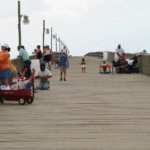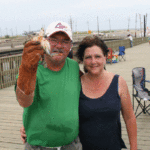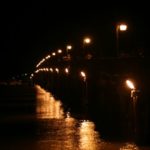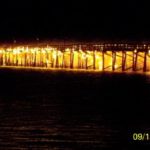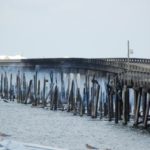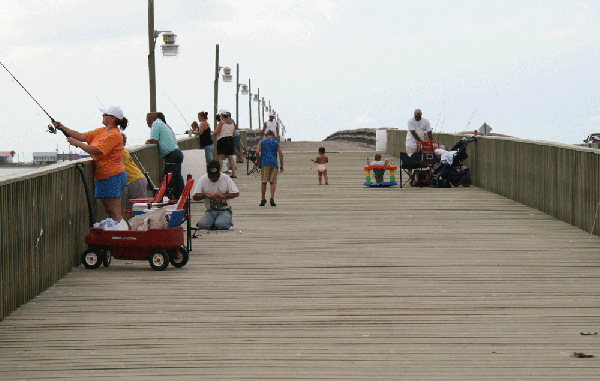
Grand Isle’s Caminada Pass bridge is the place to go for summertime crab and trout action — no boat necessary.
After spending a hot summer day searching for speckled trout in the surf, the cool sea breeze felt good as I strolled down the old wooden bridge among a crowd of people after dark.
Singles, couples and families were lined up side by side along the railing, and the smell of grilled food hung in the air as a country tune played on a distant boom box.
The bustle of people and sights and sounds reminded me of a parish fair midway. But these folks were not out for carnival rides: Lined up along the old Highway 1 bridge, they were after trout.
Fishing under the lights at Grand Isle’s Caminada Pass bridge is a family thing, and the action can be as hot as a blistering dog day of summer.
Highway 1 is the only way in or out of Grand Isle. Snaking through the marsh from Leeville to Fourchon, it crosses Caminada Pass to reach the island. Josie Cheramie of the Grand Isle Tourist Commission said the wooden Caminada bridge dates back many years.
“The first car rolled over the old bridge on Sept. 5, 1932,” Cheramie said.
According to Ray Santiny, Grand Isle’s town clerk, a modern concrete bridge was put in during the 1960s.
“They then tore down the middle span of the old wooden bridge to keep cars off it. It’s been a public fishing bridge ever since, and the city of Grand Isle maintains it,” Santiny said.
The bridge has suffered a lot in the past few years. Hurricane Katrina destroyed part of it in 2005, but officials repaired the damage and reopened the popular fishing spot three years later.
Then, on the night of Sept. 19, 2009, an electrical fire sparked a blaze that burned down much of the eastern side of the bridge.
The western portion was unaffected by the fire,however, and today the unburned section on the east side has been reopened to fishing — and plans are in the works to rebuild the part that was destroyed.
I discovered this fishing hotspot by accident while on my first trip to Grand Isle to fish for speckled trout. Arriving at Bridge Side Marina in early afternoon after a long drive, I checked into my room and decided to stretch my legs a bit. The old bridge sits adjacent to the marina, and seemed like a good place to take a walk.
I soon ran into Charlie and Lisa Theriot, who had also just arrived and were preparing for an afternoon of crabbing.
“For at least 20 years, we’ve been coming here in the summer and staying a week, sometimes two,” Charlie Theriot said. “We used to come with our kids, but it’s just us now. We always come in the latter part of July or August when the crabs are running.”
Being a North Louisiana boy, I have no experience in crabbing, so the Theriots gave me a quick lesson. Charlie explained that it isn’t a high-tech sport.
“We go to Walmart and buy a dozen nets for a couple dollars a piece,” Charlie Theriot said. “They’ll usually last a week’s worth of fishing.”
Theriot also keeps his bait expenses to a minimum.
“Any kind of chicken or turkey meat like legs, necks and thighs will work,” he said. “I use chicken thighs because that’s about the cheapest.”
Because the bridge is about 20 feet high, Theriot had to tie a long heavy cord to his nets to reach the water.
“I tie mine between the bridge pilings so they won’t get hung up,” he said. “When the crabs are running, it really doesn’t matter where you put them. Any place along the bridge is good and at any depth.”
The crabs seemed to be running well this particular afternoon. The Theriots had only been on the bridge for about 30 minutes but already had about a dozen in their bucket.
While we talked, Charlie Theriot stopped every couple of minutes to help wife Lisa when she pulled up a net.
Wearing heavy welder’s gloves, Theriot reached down and picked up one of the crabs to show me.
“These are running real nice-size,” he said. “We’ll catch one, maybe two at a time. Sometimes you might get three, but then one often will get out. If you stayed out here all night you could fill an ice chest.
“We used to keep a lot, but now it’s just the two of us so we might keep a couple dozen.”
Theriot went on to explain that, while crabs are found around the bridge in huge numbers, you can’t keep everything you catch.
“You can catch a bunch, but you have to throw back females with eggs on them,” he said. “Sometimes for every 10 you catch you have to throw back five.”
As I left, Theriot echoed a sentiment I was to hear repeated over and over.
“I’m glad to see them maintain the bridge,” he said. “Not everyone can afford a $30,000 boat, and it’s almost as good fishing here as in a boat.
“What I like about the bridge is that you can come out here at night and it’s cool, with a breeze. You can bring the wife and kids, the whole family.”
While crabbing is popular on the bridge during the day, things really crank up after dark.
Starting about sundown, groups of people head out to lay claim to one of the many large lights that shine down on the water. At night, these lights attract shrimp, crab, mullet and other bait, which in turn bring in an incredible number of speckled and white trout.
A summer night on the Caminada Pass bridge is something you have to see to believe. Families pack up all their fishing tackle, bait, lawn chairs and ice chests onto wagons, and drag it all out on the old roadbed.
There was a beautiful full moon playing peek-a-boo in the clouds this night, and a distant thunderstorm entertained us with impressive flashes of lightning.
Near the bridge, porpoises cruised along the outer fringe of light, blowing air and chasing baitfish. Some of the fishermen humored themselves by throwing out croakers or white trout and watching the porpoises scarf them down.
I happened to check things out not long after sundown on a Friday night, and found most of the spots beneath the lights were already occupied.
While walking among the bustling crowd, there was a squeal of excitement as a young lady standing in a group of people landed a trout. From the good-natured ribbing and laughter, you could tell this was a bunch that enjoyed their time on the bridge.
I found that Bert Stilley and W.C. Needham had been making annual summer trips to Grand Isle with family and friends since 2003. On this occasion, they had nine campers set up at Bridge Side Marina.
“We might catch 15 or 20 or 30 keepers on a good night,” Stilley said. “For the trout, we use small plastic grubs like a sparkle beetle or small Bass Assassin. It’s the very same kind you would use for crappie, and we put them on a tandem shad rig.”
The bridge is better known for the sheer number of fish caught rather than impressive size.
“Our biggest speckled trout on the bridge will run about 2 pounds,” Stilley said.
But there are larger fish to catch.
“We do catch some big reds sometimes,” Stilley said. “You can catch a lot of them off the bridge out in the middle of the channel.
“Late in the summer is better for the reds.”
Since anything caught has to be hauled up a long distance from the water to the bridge, I asked him how one lands a bull red without using very heavy tackle.
“We use a long pole with a hook on the end of it, and reach down and snatch them,” he said.
Farther down the bridge, I discovered another fisherman solved this problem by lowering a crab basket down into the water to serve as a landing net.
It was amazing to see the different varieties of tackle people used. Most had medium spinning and baitcasting equipment, including Zebco 33s, and one elderly couple had fly rods.
Some people were even armed with simple crappie-jigging poles and a long line tipped with a shrimp. When a trout sucked down the bait, the fisherman set the hook. After a brief fight, a mighty yank was given and the trout shot straight up out of the water, soared 10 feet overhead and landed with a smack on the pavement.
Bait ran from live shrimp to innumerable types of soft plastics. No matter what kind of tackle or bait was used, nearly everyone was dragging their offerings either along the surface of the water or just underneath.
I quickly realized why: Around some lights, the water literally boiled with fish.
The tide was going out, and a steady stream of shrimp and small crabs was on top of the water, riding the current. Speckled and white trout by the dozens zoomed out of the depths like sharks to gulp them down.
“Fishing is good as long as you have either an incoming or outgoing tide,” Needham said.
On this particular night water conditions were apparently perfect.
While many fishermen get to the bridge at sundown to claim a good spot, the bite usually doesn’t get hot until later.
“They tend to turn on about 11 p.m,” Needham said.
I had noticed that some families come prepared to spend the night by setting up pallets among their ice chests and lawn chairs so tired youngsters could be put down for naps.
Beneath one light, so many trout were boiling the surface that I stopped and tried to catch them on camera. After watching me for a moment, a man nearby asked, “What you trying to get?”
When I explained, he pointed to his right.
“Look down the bridge out in the middle of the current,” he said.
Glancing up, I saw the water along the bridge boiling like a crawfish pot.
Fish were literally hitting everywhere in an impressive feeding frenzy. Watching them for a moment, the veteran bridge fisherman admitted it was an unusual sight.
“I’ve never seen that many fish,” he said.
The next day, while leaving Grand Isle, I happened to see a half dozen people ganged up around an array of rods, chairs and ice chests on the western section of the bridge. Curious as to whether they were having any luck in the daytime, I walked out to chat.
I discovered that Joe Fincher and his friends had been on the bridge for about 24 hours. Although badly sunburned, they were obviously having a good time.
“We got here yesterday and stayed all night,” Fincher said. “We just sort of camped out, fishing for awhile and then sleeping in the cars for awhile.
“We’ve been out here all day today, and will stay tonight and go back home tomorrow.”
I asked Fincher if they were catching anything and he just sort of shrugged.
“A few,” he said.
After talking awhile, one of his friends caught a white trout, so I asked to see their catch as he put it in the large cooler.
“A few,” as it turned out, was quite a haul. The ice chest was full of trout.
“We probably have 150 to 200, and we must have thrown back several hundred,” Fincher said. “Most are white trout because there’s no limit on them; you can keep any number and any size.
“They bite best when it starts getting dark and through the night. At night, the water just boils with fish feeding on shrimp beneath the lights. You ever see a pot of grease with french fries? That’s what it looks like. They start boiling up by the hundreds.
“It’s mostly white trout, but you catch some specks. Then they’ll disappear for awhile, and later they’ll do it again.”
But Fincher said that they catch more than trout.
“We were here last week and caught two bull reds on cracked crab,” he said. “Both went 34 pounds each, and we had seven break off. We’ve also had quite a few break off today.”
As I left, Fincher gave some last-minute advice on fishing the Caminada Bridge.
“Just bring your lawn chairs and have a good time.”
DESTINATION INFORMATION
Grand Isle is located near the entrance of Barataria Bay on the Louisiana Gulf Coast, and is about a two-hour drive from New Orleans. From New Orleans take Highway 90 west toward Houma and turn south on Highway 308 or Highway 1 to Golden Meadow and Leeville. Note that the toll bridge at Leeville is now open and you have to obtain a Geaux Pass at one of the kiosks in Golden Meadow, Leeville or online at www.geauxpass.com. The public fishing bridge is on the right and parallel to the modern bridge as you cross Caminada Pass onto Grand Isle.
ACCOMMODATIONS: There are numerous motels and cabins in Grand Isle, but Bridge Side Marine is the most convenient for fishing the Caminada Pass bridge. The marina is located on the right of Highway 1 at the base of the bridge. Bridge Side has comfortable rooms to rent, RV spaces, live bait, tackle and excellent food. Reservations can be made at 985-787-2419.
For more information, call the Grand Isle Tourist Commission at 985-787-2997.
